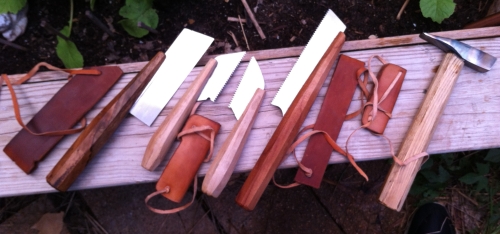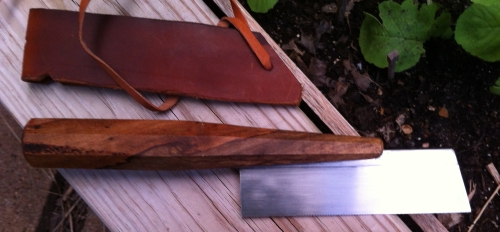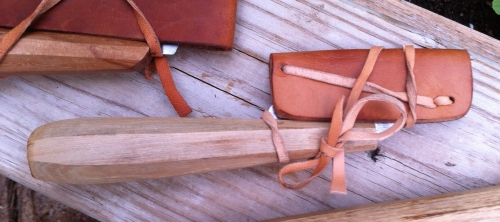I am charmed by rustic tools. Extreme simplicity, implied durability and the clear functionality speak strongly to me. I am delighted when I can capture that in a tool that I make.
Here are several recently made tools that are unique, simple, solid and quite functional.

This shows them sheathed and unsheathed. I tried quite a few variations on sheath making and am finally happy with one of the results. All of the saws have handles made of pecan. The difference is how the wood was preserved.
The range of these saws gives me an chance to try out several things. Shape, size, variations on handle profiles, length, tpi and sheath form. A saw like this is one of the worst shapes for putting a sheath on, so getting it right can require a bit of trial and error.
This is the first one I made. I blogged on it previously here…
The sheath is horrible, too good to replace to awkward to not want to. The handle is a lovely spalted pecan. A touch of rot to the wood can make for a magnificent display!
Here are my two most recent versions. Short blades and short handles. The cross sections of the handles are what really tells them apart. One is thicker top to bottom, the other is thicker side to side. I like them both so far, so I can’t tell you if one is superior to the other yet. The top sheath is what I will be copying from here one. Easy to put on, and it stays there solidly.
Here are the two side by side. The wood is much lighter and less dramatic in person. The picture is much nicer than the plain near featureless white handles the human eye sees. The top most photo in this article shows the color more accurately. I took freshly cut pecan, roughly shaped the handles and then boiled them for hours in my wax mix. My experimental control, was merely sealed at both ends with wax. The control has several splits, so this may be the method I use to preserve small fresh bits of wood.
This is one that I made a much longer handle on. It is of properly aged, and cared for pecan.
Another fun part of making rustic art, is the low materials cost. They still take time to make, but that is not always a bad thing for a hobby.
Bob







 A page Dedicated to My Writing
A page Dedicated to My Writing
Yep, that’s pecan for you. I’m always amazed at the range of colors you can get out of a single log.
Steve – good to see you in here! Maybe someone should invite Josh???? Anyway, Bob, excellent idea. I have been using an old model x-acto saw (for sawing balsa) since your last blog post and am still getting the joint just a bit wide…. ideas????
Skip
I’ll make you one, Skip!
Bob
Hey Bob,
Great saws! I tried the striking saw and had very nice results with it. As you know I mainly cut the small woods and so I tried it out on on some birch ply that was 1/8 and 1/4 inch, a piece of 3/8 square balsa and some bass wood. I was amazed at how fast it cut and even more so the lack of required hand pressure needed to make a coordinated cut. I felt that the heaviness of the blade as well as the more cutting teeth to the inch helps it to out perform even my usual razor saw. Also the length of cutting width of the blade is just enough for these little cuts to include “follow through” so that worked out as well. Finally, the overall balence of the tool, how it feels in the hand, and while being used is really about as good as it can get it seems. I do like the contours of the handle and the flats are an interesting touch but I’d be curious to try one with a rounded handle as well.
Thank you for the tool,
John
Thank you Bob! I am certainly growing to appreciate your custom made handles, especially the pecan!
But I was talking more about my technique, I think if i could snuggle up to the board – I am marking off of – better without the handle hitting it, it would help some… The lines are certainly straight and sure, without having to use a straight edge.
Skip
Hey Bob!!!!!!!!!
Thank you SO much for the blade!!
IN ANY CASE,
* have brought the blade home and started to generate so many ideas with it as you can imagine.
*Well, to start with I was considering using the copper rod idea as pins for the knife-to-be-made for the blade, and would just like to consider whether something like brass might hold up better and be just as ornate for the intended use here. Please let me know what you think.
*Another thing being that just to mention the type of handle wood that I shall use for it: I have a little while back purchased some really fine examples of premium cocobolo wood that is my chosen handle material from knifekits.com . I think that both are cocobolo but at least one of them is as I’d ordered them to be. Anyways, one piece is lighter and orangish in color while the other is a much richer brown looking example. Both are essentially slab-cut but the darker brown piece being slightly more quarter-sawn on one part of it. The orangish piece is more consistently grained its entire length. -Perhaps it makes no difference once glued and shaped and pinned up with the blade for final presentation and use, I’m thinking. Both pieces are about 4″x12″ and about 1/4″ thick. What advice can you give me though on the wood, can certainly show you what I’m working with, even as I go.
?any ideas on possible hilt pinning/embellishments????
The blade and workmanship is remarkable. Such a project will take great care and some bit of time for me to do well but will keep you posted on the progress.
John 🙂